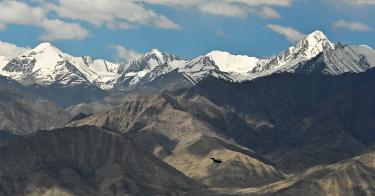For the last two months, China and India have been embroiled in a series of standoffs along their disputed Himalayan border that has become the worst crisis in Sino-Indian relations in over 50 years. In some ways, this is familiar territory: India records several hundred Chinese transgressions across the de facto border, known as the Line of Actual Control (LAC), annually, and this marks the fourth prolonged border crisis in seven years. However, the still-unfolding standoffs represent a far more novel and consequential crisis, threatening the tenuous framework that has previously prevented China-India relations from devolving into open rivalry.
It was clear from the outset this border crisis would be different. Following uncommon, but not unprecedented, reports of fistfighting between Chinese and Indian border patrols in early May, the Indian press made a dramatic revelation. The Chinese military had massed thousands of soldiers and towed artillery at multiple noncontiguous locations along the LAC where the Indian union territory of Ladakh meets Tibet, even temporarily crossing the LAC near the Galwan River in May.
What’s worse, the Chinese army was probing in sectors of the LAC, including Sikkim and the Galwan River, long considered settled by New Delhi. Perhaps most concerning, the army seemed to be trying to alter the status quo by occupying a so-called gray zone along the banks of Pangong Lake, a particularly contentious stretch of the border where the very location of the LAC is disputed.
The proximate cause of China’s border maneuvers was the subject of feverish speculation in India. Was Beijing following in the footsteps of its “all-weather friend” Pakistan by responding to New Delhi’s August 2019 decision to revoke Kashmir’s autonomous statehood? Was it objecting to new Indian restrictions on Chinese investment? Lashing out amid international pressure over the COVID-19 pandemic and growing domestic incentives to project a muscular nationalism abroad? Or should the Chinese be taken at their word? Were they, as they had done numerous times in the past, objecting to recent Indian infrastructure upgrades near the LAC by presenting it with a fait accompli? To this day that remains the most likely explanation. But if Beijing was drawing from a familiar playbook, its tactics this time appeared far more aggressive.
After several inconclusive rounds of talks between local officers, senior Chinese and Indian commanders met on June 6 and agreed to ease tensions at the border. One week later, with the crisis seemingly unwinding, disaster struck. On the night of June 15, the LAC witnessed a terrible spasm of violence near the Galwan River. The rules of engagement near the LAC bar the use of live ammunition—but not brutal, medieval combat. Fighting along the narrow ridgeline of a Himalayan mountain, 20 Indian soldiers were killed. Some were beaten to death with metal rods and spiked clubs. Others literally fell, or were pushed, to their death. China hasn’t reported its own casualties, as “comparisons may trigger antagonism on both sides.”
The precise details and location of that fateful brawl remain the subject of debate, but the fight reportedly began when Indian forces approached the LAC to confirm China’s compliance with the disengagement pact. The violence erupted when the Indian patrol demanded the dismantlement of a Chinese outpost straddling the LAC on India’s side.
In the aftermath, Beijing and Delhi blamed each other for violating the LAC and initiating hostilities. Surprisingly, China also laid claim to the entire Galwan River valley, a departure from outside analysts’ prior understanding of China’s claims there. Indian External Affairs Minister S. Jaishankar insisted China’s actions “reflected an intent to change the facts on the ground in violation of all our agreement.”
At the same time, both sides signaled their interest in further de-escalating the situation. Neither country has shown any interest in a wider conflict, and an 11-hour meeting between senior military commanders on June 22 focused on future steps for de-escalation. For now, the LAC near the Galwan River has fallen quiet again.
There are several catches here. First, recent reports aided by satellite imagery suggest that, far from disengaging from the site of the Galwan brawl (which either lies right on the LAC or 100 meters on India’s side, depending on the map), China appears to have substantially reinforced its position there. There are now Chinese defensive structures, shelters, trenches, and vehicles visible, as well as culverts constructed over the Galwan River “near the spot where bulldozers appeared to have stopped the flow of the waters” in May, the Indian broadcaster NDTV reported. Other reports suggest China continues to mass forces and erect structures near the LAC in other parts of the eastern sector, including the Depsang Valley.
Second, even if the two sides return to the June 6 de-escalation road map covering multiple sites at the Galwan River, Depsang, Gogra, and Hot Springs, there’s a more intractable standoff unfolding farther south, at Pangong Lake. In recent years, the banks of the lake have become a tinderbox, host to a growing number of hostile confrontations between the two sides. With no mutual agreement on the LAC there, a several-kilometer stretch along the northern bank between spits of land known as “Finger 4” and “Finger 8” became a volatile gray zone, claimed and patrolled by both sides. Notably, China has enjoyed a superior position there, having built a road through the area in 1999, while Indian soldiers are forced by inhospitable geography to patrol the contentious stretch on foot.
Last month, several hundred Chinese troops pushed west from their base near Finger 8 to a point near India’s easternmost base at Finger 4 and set up camp, erecting dozens of new structures along the way, seizing the high ground, and staking claim over the Pangong gray zone. The Indian media is now embroiled in a debate over whether China has effectively seized Indian territory while reviewing Delhi’s options to respond.
Unsurprisingly, the Indian public is outraged. A large and growing segment of the Indian elite had already grown increasingly disenchanted with China in recent years, frustrated by Beijing’s ongoing patronage to Pakistan, its probing at the border, and its growing footprint in India’s immediate neighborhood. As a result, they have also grown increasingly desirous of a stronger partnership with the United States. Now, those calls have been amplified and joined by a broader cross-section of Indian society, including those once hopeful for a more constructive relationship with China, or at least more equidistance between Washington and Beijing. “The policy of riding on two horses – getting closer to the US without ruffling too many feathers in China – has run its course,” writes the researcher Sushant Sareen. “India will have to decide whether to reinforce a failed policy, or forge a new one which involves a much closer alliance with the US and its allies.”
For its part, the Trump administration has been largely reserved in its public commentary on the crisis. In May, Principal Deputy Assistant Secretary of State Alice Wells warned of China’s “constant aggression, the constant attempt to shift the norms, to shift what is the status quo. That has to be resisted whether it’s in the South China Sea … or whether it’s in India’s own backyard.” More recently, administration officials have made only passing references to the LAC crisis. However, this is likely less a sign of impartiality from the United States than a reflection of the Indian government’s preferences: It has traditionally cautioned Washington privately against taking too public a role in India’s disputes with China.
Over the last few decades China and India have invested considerable energy into managing their conflicts of interest and their over 2,100-mile disputed border.
It’s required both sides to strike a delicate balance, competing and sparring along numerous fault lines while maintaining the veneer of comity and avoiding crossing each other’s red lines. Occasionally, Chinese actions have upset that balance, provoking a sharp response from India. That was the case when Beijing refused to issue a visa to an Indian military officer from Kashmir in 2010; when Chinese submarines surfaced in Sri Lanka in 2014; and when the Chinese military tried to extend a road into the disputed Doklam plateau in 2017. China’s latest adventure at the border hasn’t so much disrupted the balance as reset the entire equation. China’s actions, writes the Times of India’s Indrani Bagchi, “achieved precisely the opposite of what it wanted—it has pushed India into much closer partnerships with the west.”
Some analysts contend Beijing is convinced India’s history of nonalignment will prevent it from ever drawing too close to the United States. The China expert Yun Sun and others argue the opposite: that Beijing views India as a “lost cause” and that no amount of catering to Indian sensitivities will prevent it from aligning with its more natural partner in the United States. She writes: “India is believed to be strategically unreliable to begin with and China has no interest in acquiescing to India’s attempt to advance its position on territorial disputes to trade for concessions. … If a strategic friendship with India is untenable, it frees up room for tactical gains.” With China having established its own infrastructure network along the LAC, Yun believes Beijing “wants to put an end to the infrastructure arms race” and sees India’s road-building as “an attempt to stab it in the back while China was trying to deal with” growing tensions with the United States and international criticism over the COVID-19 pandemic.
Whatever China’s calculus, it should prepare for a more confrontational posture from the Indian government in the years ahead. Within days of the fighting, the Indian press reported Delhi will “bar Chinese companies from providing any telecom equipment to state-run telcos and may also prohibit private mobile phone operators from using gear supplied by the likes of Huawei and ZTE.”
In early June, reports suggested India is considering inviting Australia to the Japan-India-U.S. trilateral naval exercise, Malabar. Beginning June 22, Chinese imports were reportedly being stalled at key Indian ports. Meanwhile, an article in India’s largest Hindi-language newspaper urges the Modi government to “reimagine its policies on Tibet, Taiwan, and Hong Kong” and “be prepared to exit organizations like the [Shanghai Cooperation Organization].” India will likely review its approach to the broad spectrum of policies that fall within the China portfolio, from the Quad and the Belt and Road Initiative to the South China Sea and the Dalai Lama.
In the near term, India will be seeking to return to the pre-May status quo at the LAC, including at Pangong Lake. If Beijing balks, Delhi’s immediate options to respond are limited and unpalatable. While there have been calls inside India for military retaliation and escalation, amid a global recession and pandemic Delhi will be reluctant to start a war over a few dozen kilometers of real estate not previously in its sovereign possession.
Over the long term, there’s more at stake than the fingers of Pangong Lake. And there are more effective, albeit less immediate, ways of imposing costs on China for its border adventure. India already enjoys the world’s third-largest military budget. Within a decade it will likely be the world’s most populous country, with the fourth-largest economy.
Many in China know this, which is why, despite its palpable disdain for India, Beijing has over the years sought to avoid a dramatic rupture with Delhi. But this is a new China, one where “Wolf Warrior” diplomats casually throw decades of more cautious diplomacy to the wind. It’s a China that may have forgotten what it means to win the battle but lose the war.
This piece originally appeared in Foreign Policy Magazine on 6/26/20




